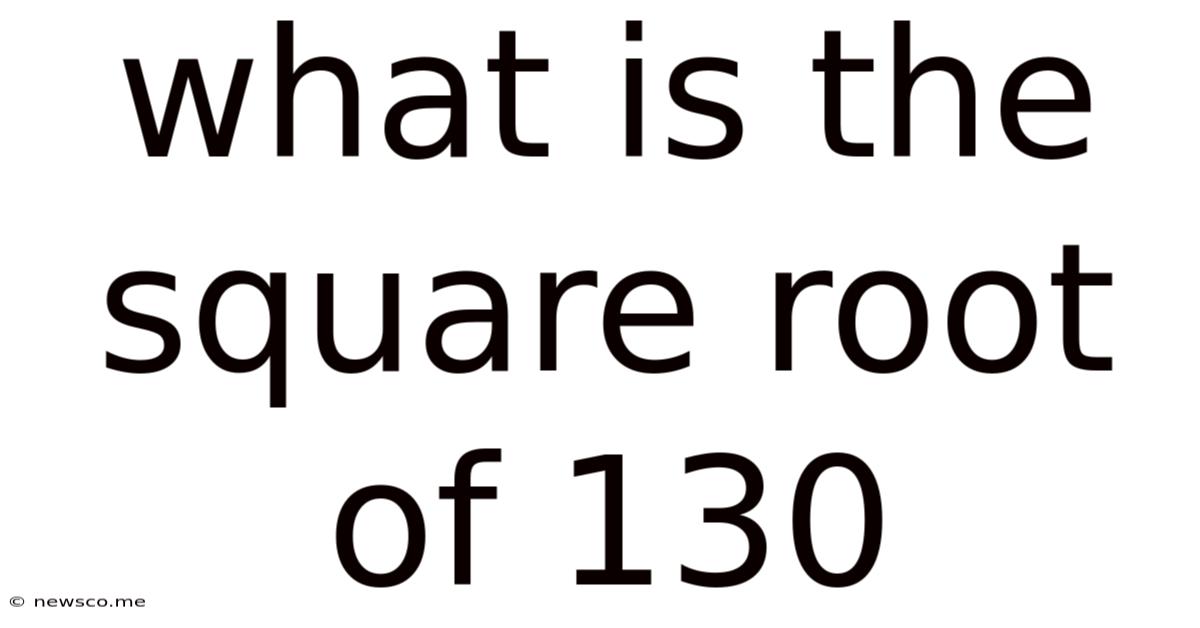What Is The Square Root Of 130
News Co
Mar 25, 2025 · 5 min read

Table of Contents
What is the Square Root of 130? Exploring the Realm of Irrational Numbers
The seemingly simple question, "What is the square root of 130?" opens a fascinating exploration into the world of mathematics, specifically the realm of irrational numbers. While a quick calculation on a calculator will yield an approximate decimal value, understanding the nature of the square root of 130 goes beyond simply finding a numerical answer. This article delves deep into this seemingly straightforward problem, examining its properties, calculation methods, and broader mathematical significance.
Understanding Square Roots
Before we tackle the square root of 130 specifically, let's establish a foundational understanding of what a square root is. The square root of a number is a value that, when multiplied by itself (squared), gives the original number. For example, the square root of 9 is 3 because 3 x 3 = 9. This is often represented mathematically as √9 = 3.
This concept is straightforward for perfect squares – numbers that result from squaring whole numbers (e.g., 1, 4, 9, 16, 25, etc.). However, many numbers don't have whole number square roots. These are where irrational numbers come into play.
Irrational Numbers: The Nature of √130
The square root of 130 falls into the category of irrational numbers. Irrational numbers are numbers that cannot be expressed as a simple fraction (a ratio of two integers). Their decimal representation goes on forever without repeating. This means we can only approximate their value, not express it exactly.
Why is √130 irrational?
130 is not a perfect square. There is no whole number that, when multiplied by itself, equals 130. Therefore, its square root cannot be expressed as a simple fraction, making it irrational.
Calculating the Approximate Value of √130
While we can't express √130 exactly, we can approximate its value using various methods:
1. Using a Calculator: The simplest method is to use a calculator. Most calculators will give a decimal approximation, typically around 11.40175425. However, it's crucial to remember that this is an approximation, not the exact value. The calculator's display is limited by its precision, and the true value of √130 has infinitely many decimal places.
2. The Babylonian Method (or Heron's Method): This is an iterative method for approximating square roots. It involves repeatedly refining an initial guess until the desired level of accuracy is reached. The formula is:
x_(n+1) = 0.5 * (x_n + (N / x_n))
Where:
x_nis the current approximationx_(n+1)is the next approximationNis the number whose square root is being calculated (in this case, 130)
Let's demonstrate with an initial guess of 11:
- Iteration 1: x₁ = 0.5 * (11 + (130 / 11)) ≈ 11.409
- Iteration 2: x₂ = 0.5 * (11.409 + (130 / 11.409)) ≈ 11.401754
As you can see, with each iteration, the approximation gets closer to the actual value. This method requires repeated calculations, but it demonstrates a powerful mathematical concept for approximating square roots.
3. Using the Long Division Method for Square Roots: This is a more manual method, suitable for understanding the underlying principles of square root calculation. It's a lengthy process, but it can be done without a calculator. Numerous online resources detail the steps involved in this method.
4. Using Estimation and Number Sense: By understanding perfect squares, we can make a reasonable estimation. Since 11² = 121 and 12² = 144, the square root of 130 must lie between 11 and 12, closer to 11.
The Significance of Irrational Numbers
The existence of irrational numbers like √130 highlights the richness and complexity of the number system. They demonstrate that not all numbers can be neatly expressed as fractions or terminating decimals. Irrational numbers are fundamental to various mathematical fields, including:
-
Geometry: Irrational numbers often appear in geometric calculations, such as calculating the diagonal of a square (involving √2) or the circumference of a circle (involving π).
-
Trigonometry: Trigonometric functions often produce irrational results.
-
Calculus: Irrational numbers play a vital role in the concepts of limits and derivatives.
-
Physics and Engineering: Many physical phenomena involve irrational numbers, such as the calculation of wave frequencies and the modelling of natural phenomena.
Applications and Real-World Examples
While it might seem abstract, the square root of 130, like other irrational numbers, has practical applications. Consider the following examples:
-
Construction and Engineering: Imagine calculating the length of a diagonal brace in a rectangular structure with sides of specific lengths. The diagonal's length might involve an irrational square root.
-
Computer Graphics and Game Development: Rendering smooth curves and shapes often requires calculations involving square roots and other irrational numbers.
-
Financial Modeling: Complex financial models often use irrational numbers in their calculations, as they are essential for simulating fluctuating variables, such as interest rates or stock prices.
Conclusion: More Than Just a Number
The seemingly simple question of finding the square root of 130 leads us on a journey into the world of irrational numbers. It underscores the limitations of our ability to express certain numbers precisely and highlights the beauty and complexity of the mathematical system. While we can only approximate its value, understanding its nature and its broader implications within mathematics and various real-world applications significantly expands our mathematical comprehension. The concept extends beyond just calculating a numerical value; it represents a fundamental aspect of mathematical structure and the elegant complexity inherent in the number system. Further exploring concepts like continued fractions and other approximation techniques can deepen the understanding of irrational numbers like the square root of 130.
Latest Posts
Related Post
Thank you for visiting our website which covers about What Is The Square Root Of 130 . We hope the information provided has been useful to you. Feel free to contact us if you have any questions or need further assistance. See you next time and don't miss to bookmark.